2012 DODGE AVENGER engine overheat
[x] Cancel search: engine overheatPage 394 of 514
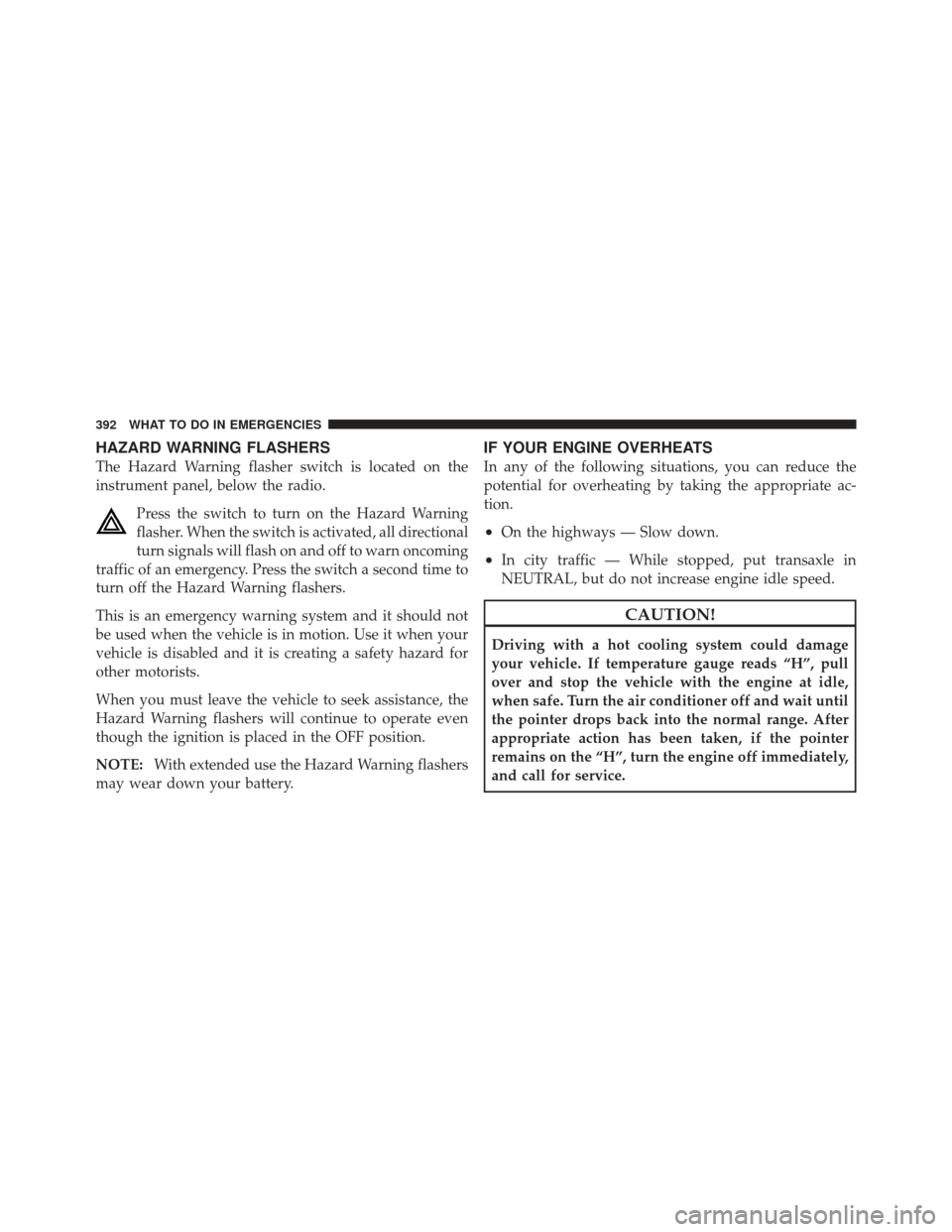
HAZARD WARNING FLASHERS
The Hazard Warning flasher switch is located on the
instrument panel, below the radio.Press the switch to turn on the Hazard Warning
flasher. When the switch is activated, all directional
turn signals will flash on and off to warn oncoming
traffic of an emergency. Press the switch a second time to
turn off the Hazard Warning flashers.
This is an emergency warning system and it should not
be used when the vehicle is in motion. Use it when your
vehicle is disabled and it is creating a safety hazard for
other motorists.
When you must leave the vehicle to seek assistance, the
Hazard Warning flashers will continue to operate even
though the ignition is placed in the OFF position.
NOTE: With extended use the Hazard Warning flashers
may wear down your battery.
IF YOUR ENGINE OVERHEATS
In any of the following situations, you can reduce the
potential for overheating by taking the appropriate ac-
tion.
•On the highways — Slow down.
•In city traffic — While stopped, put transaxle in
NEUTRAL, but do not increase engine idle speed.
CAUTION!
Driving with a hot cooling system could damage
your vehicle. If temperature gauge reads “H”, pull
over and stop the vehicle with the engine at idle,
when safe. Turn the air conditioner off and wait until
the pointer drops back into the normal range. After
appropriate action has been taken, if the pointer
remains on the “H”, turn the engine off immediately,
and call for service.
392 WHAT TO DO IN EMERGENCIES
Page 395 of 514
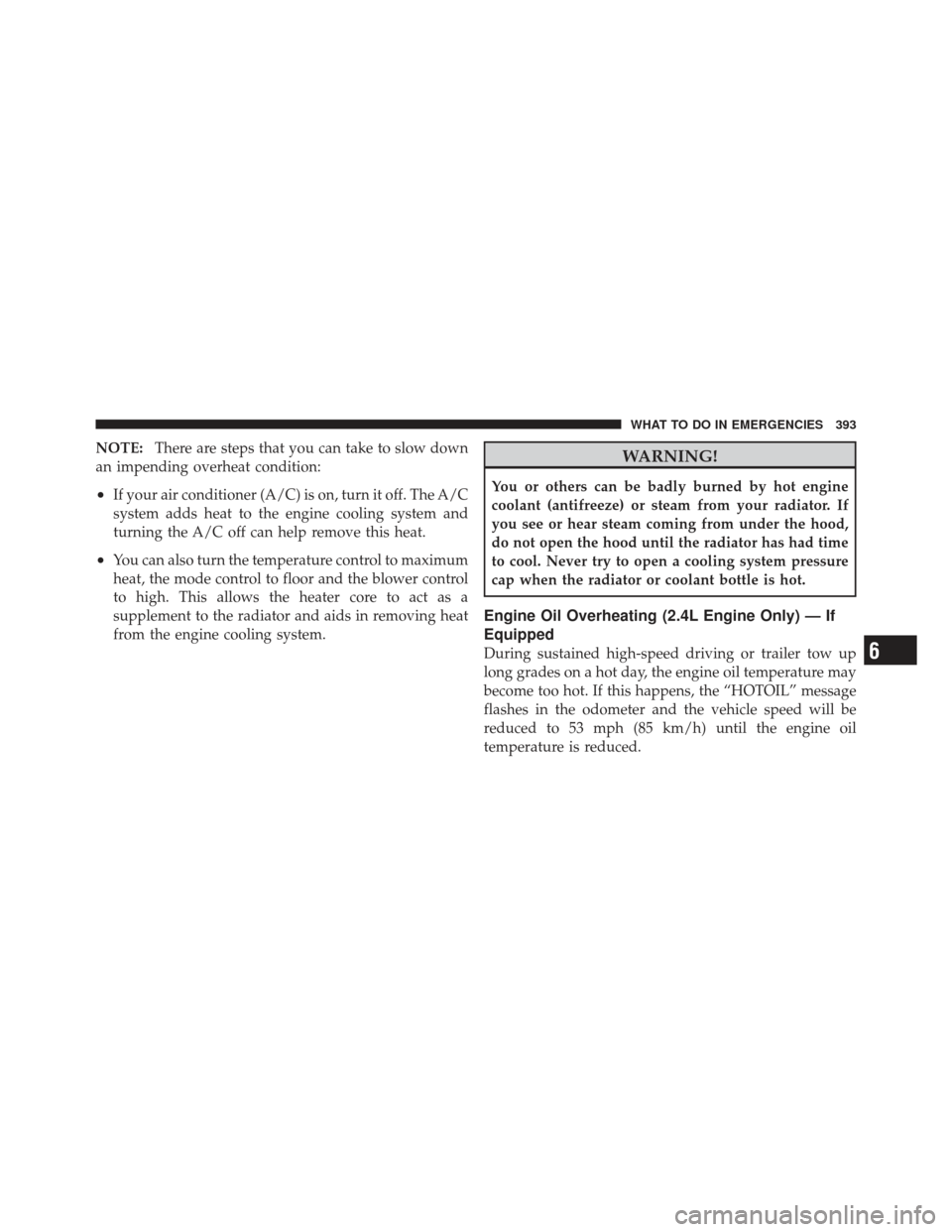
NOTE:There are steps that you can take to slow down
an impending overheat condition:
•If your air conditioner (A/C) is on, turn it off. The A/C
system adds heat to the engine cooling system and
turning the A/C off can help remove this heat.
•You can also turn the temperature control to maximum
heat, the mode control to floor and the blower control
to high. This allows the heater core to act as a
supplement to the radiator and aids in removing heat
from the engine cooling system.
WARNING!
You or others can be badly burned by hot engine
coolant (antifreeze) or steam from your radiator. If
you see or hear steam coming from under the hood,
do not open the hood until the radiator has had time
to cool. Never try to open a cooling system pressure
cap when the radiator or coolant bottle is hot.
Engine Oil Overheating (2.4L Engine Only) — If
Equipped
During sustained high-speed driving or trailer tow up
long grades on a hot day, the engine oil temperature may
become too hot. If this happens, the “HOTOIL” message
flashes in the odometer and the vehicle speed will be
reduced to 53 mph (85 km/h) until the engine oil
temperature is reduced.6
WHAT TO DO IN EMERGENCIES 393
Page 412 of 514
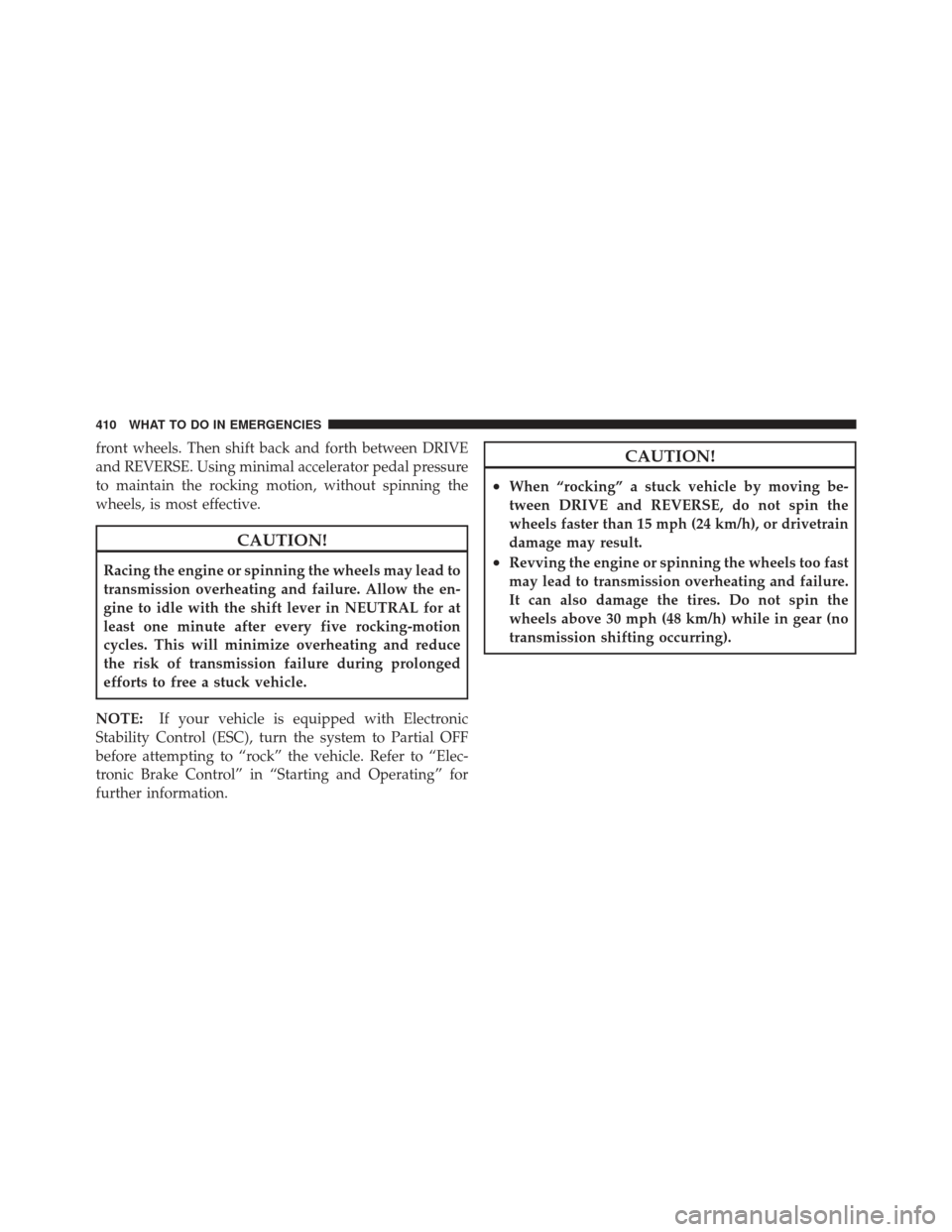
front wheels. Then shift back and forth between DRIVE
and REVERSE. Using minimal accelerator pedal pressure
to maintain the rocking motion, without spinning the
wheels, is most effective.
CAUTION!
Racing the engine or spinning the wheels may lead to
transmission overheating and failure. Allow the en-
gine to idle with the shift lever in NEUTRAL for at
least one minute after every five rocking-motion
cycles. This will minimize overheating and reduce
the risk of transmission failure during prolonged
efforts to free a stuck vehicle.
NOTE: If your vehicle is equipped with Electronic
Stability Control (ESC), turn the system to Partial OFF
before attempting to “rock” the vehicle. Refer to “Elec-
tronic Brake Control” in “Starting and Operating” for
further information.
CAUTION!
•When “rocking” a stuck vehicle by moving be-
tween DRIVE and REVERSE, do not spin the
wheels faster than 15 mph (24 km/h), or drivetrain
damage may result.
•Revving the engine or spinning the wheels too fast
may lead to transmission overheating and failure.
It can also damage the tires. Do not spin the
wheels above 30 mph (48 km/h) while in gear (no
transmission shifting occurring).
410 WHAT TO DO IN EMERGENCIES
Page 436 of 514
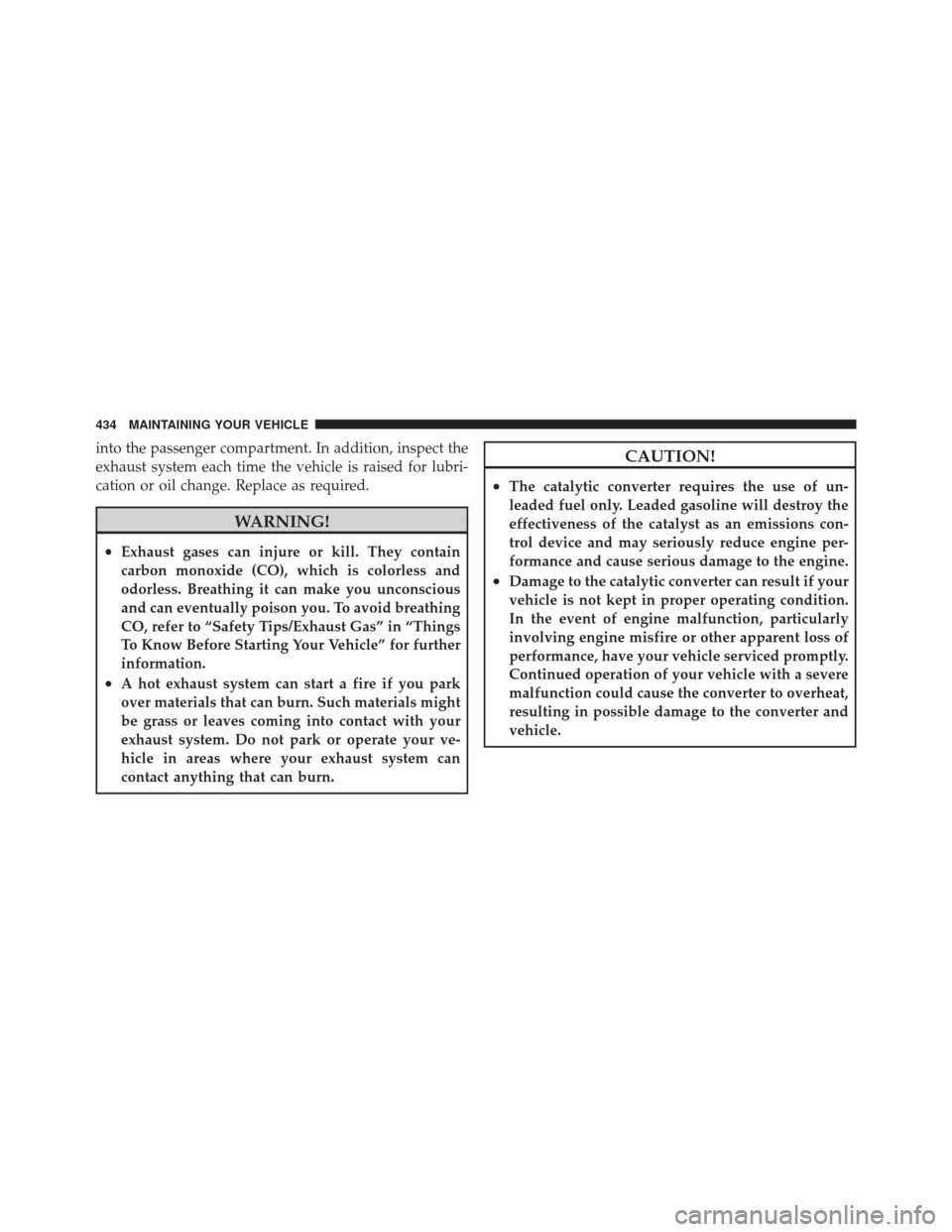
into the passenger compartment. In addition, inspect the
exhaust system each time the vehicle is raised for lubri-
cation or oil change. Replace as required.
WARNING!
•Exhaust gases can injure or kill. They contain
carbon monoxide (CO), which is colorless and
odorless. Breathing it can make you unconscious
and can eventually poison you. To avoid breathing
CO, refer to “Safety Tips/Exhaust Gas” in “Things
To Know Before Starting Your Vehicle” for further
information.
•A hot exhaust system can start a fire if you park
over materials that can burn. Such materials might
be grass or leaves coming into contact with your
exhaust system. Do not park or operate your ve-
hicle in areas where your exhaust system can
contact anything that can burn.
CAUTION!
•The catalytic converter requires the use of un-
leaded fuel only. Leaded gasoline will destroy the
effectiveness of the catalyst as an emissions con-
trol device and may seriously reduce engine per-
formance and cause serious damage to the engine.
•Damage to the catalytic converter can result if your
vehicle is not kept in proper operating condition.
In the event of engine malfunction, particularly
involving engine misfire or other apparent loss of
performance, have your vehicle serviced promptly.
Continued operation of your vehicle with a severe
malfunction could cause the converter to overheat,
resulting in possible damage to the converter and
vehicle.
434 MAINTAINING YOUR VEHICLE
Page 437 of 514

Under normal operating conditions, the catalytic con-
verter will not require maintenance. However, it is im-
portant to keep the engine properly tuned to assure
proper catalyst operation and prevent possible catalyst
damage.
NOTE:Intentional tampering with emissions control
systems can result in civil penalties being assessed
against you.
In unusual situations involving grossly malfunctioning
engine operation, a scorching odor may suggest severe
and abnormal catalyst overheating. If this occurs, stop
the vehicle, turn off the engine and allow it to cool.
Service, including a tune-up to manufacturer’s specifica-
tions, should be obtained immediately. To minimize the possibility of catalytic converter dam-
age:
•Do not shut off the engine or interrupt the ignition,
when the transmission is in gear and the vehicle is in
motion.
•Do not try to start the engine by pushing or towing the
vehicle.
•Do not idle the engine with any spark plug wires
disconnected or removed, such as when diagnostic
testing, or for prolonged periods during very rough
idle or malfunctioning operating conditions.
7
MAINTAINING YOUR VEHICLE 435
Page 441 of 514

WARNING!
•The warning words “DO NOT OPEN HOT” on
the cooling system pressure cap are a safety pre-
caution. Never add engine coolant (antifreeze)
when the engine is overheated. Do not loosen or
remove the cap to cool an overheated engine. Heat
causes pressure to build up in the cooling system.
To prevent scalding or injury, do not remove the
pressure cap while the system is hot or under
pressure.
•Do not use a pressure cap other than the one
specified for your vehicle. Personal injury or en-
gine damage may result.
Disposal Of Used Engine Coolant
Used ethylene glycol based engine coolant (antifreeze) is
a regulated substance requiring proper disposal. Check
with your local authorities to determine the disposalrules for your community. To prevent ingestion by ani-
mals or children, do not store ethylene glycol based
engine coolant (antifreeze) in open containers or allow it
to remain in puddles on the ground. If ingested by a child
or pet, seek emergency assistance immediately. Clean up
any ground spills immediately.
Coolant Level
Four-Cylinder Engines –
the coolant bottle provides a
quick visual method for determining that the engine
coolant (antifreeze) level is adequate. With the engine
idling and warm to normal operating temperature, the
level of the engine coolant (antifreeze) in the bottle
should be between the “ADD” and “FULL” lines, shown
on the bottle.
Six-Cylinder Engines – the level of the engine coolant
(antifreeze) in the pressurized coolant bottle should be
between the “COLD” and “FULL” range on the bottle
when the engine is cold.
7
MAINTAINING YOUR VEHICLE 439
Page 499 of 514

Oil Synthetic........................ 426
Overheating ........................ 392
Starting ........................... 298
Temperature Gauge ................... 196
Engine Oil Viscosity ...................... 425
Enhanced Accident Response Feature .......... 68
Entry System, Illuminated .................. 21
Ethanol ............................... 366
Event Data Recorder ...................... 71
Exhaust Gas Caution ................... 86,369
Exhaust System ....................... 86,433
Extender, Seat Belt ........................ 57
Exterior Lights .......................... 89
Fabric Care ............................ 450
Filler Location Fuel .................... 196,373
Filters Air Cleaner ......................... 427
Air Conditioning .................. 290,430Automatic Transmission
................ 446
Engine Oil ....................... 426,464
Engine Oil Disposal ................... 426
Flash-To-Pass ........................... 153
Flashers .............................. 392
Hazard Warning ..................... 392
Turn Signal ....................... 89,461
Flexible Fuel Vehicles Cruising Range ...................... 372
Engine Oil ......................... 371
Fuel Requirements ................. 369,371
Maintenance ........................ 373
Replacement Parts .................... 372
Starting ........................... 372
Flooded Engine Starting ................... 299
Floor Console .......................... 182
Fluid Capacities ......................... 463
Fluid Leaks ............................. 89
10
INDEX 497
Page 505 of 514
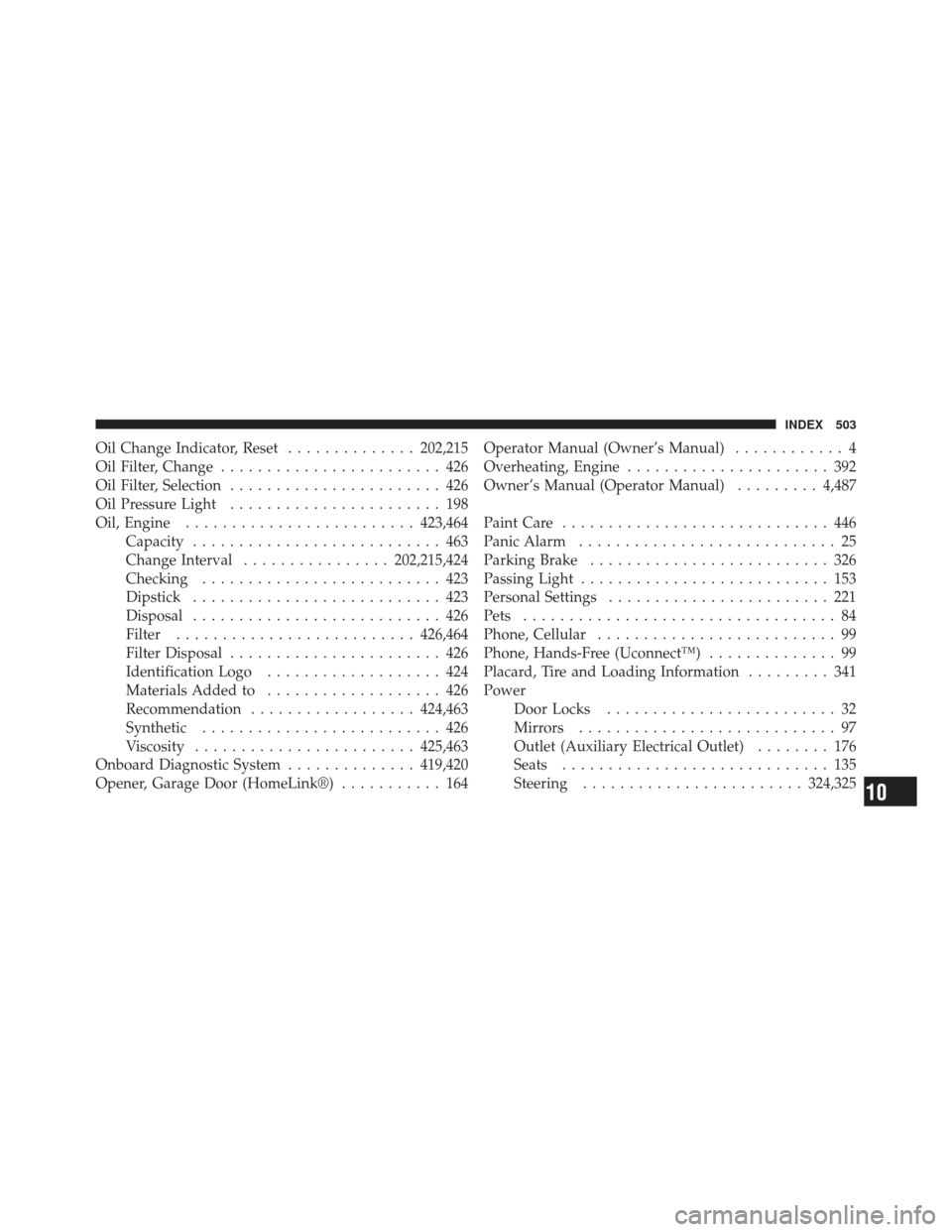
Oil Change Indicator, Reset..............202,215
Oil Filter, Change ........................ 426
Oil Filter, Selection ....................... 426
Oil Pressure Light ....................... 198
Oil, Engine ......................... 423,464
Capacity ........................... 463
Change Interval ................ 202,215,424
Checking .......................... 423
Dipstick ........................... 423
Disposal ........................... 426
Filter .......................... 426,464
Filter Disposal ....................... 426
Identification Logo ................... 424
Materials Added to ................... 426
Recommendation .................. 424,463
Synthetic .......................... 426
Viscosity ........................ 425,463
Onboard Diagnostic System ..............419,420
Opener, Garage Door (HomeLink®) ........... 164Operator Manual (Owner’s Manual)
............ 4
Overheating, Engine ...................... 392
Owner’s Manual (Operator Manual) .........4,487
Paint Care ............................. 446
Panic Alarm ............................ 25
Parking Brake .......................... 326
Passing Light ........................... 153
Personal Settings ........................ 221
Pets .................................. 84
Phone, Cellular .......................... 99
Phone, Hands-Free (Uconnect™) .............. 99
Placard, Tire and Loading Information ......... 341
Power Door Locks ......................... 32
Mirrors ............................ 97
Outlet (Auxiliary Electrical Outlet) ........ 176
Seats ............................. 135
Steering ........................ 324,325
10
INDEX 503